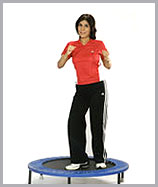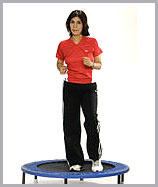 Bounce your way to back fitness. Trampoline rebounding is a great way to lose weight, gain cardiovascular benefits and have fun working out at the same time.
Bounce your way to back fitness. Trampoline rebounding is a great way to lose weight, gain cardiovascular benefits and have fun working out at the same time.
The trampoline is a safe, efficient and effective workout device that you can use at home while listening to music or watching television.
 Gymnasts and acrobats often use an elevated elastic canvas or net bed as a performing surface. The trampoline is a little more than just that. A spring or rubber suspension anchors the elastic canvas bed to a metal frame of table height. The sides are padded and the springs beneath cause the performer to bounce upward.
Gymnasts and acrobats often use an elevated elastic canvas or net bed as a performing surface. The trampoline is a little more than just that. A spring or rubber suspension anchors the elastic canvas bed to a metal frame of table height. The sides are padded and the springs beneath cause the performer to bounce upward.
While using the trampoline, concentrate on pushing down, using the balls of the feet, and not on the jumping-up movement. Contract the abdominals and maintain correct body alignment and posture during the workout.
Utilizing the laws of physics, rebounding is unique since it uses the natural laws of gravity to stimulate every cell of the body. We are all subject to gravity, but on the trampoline every cell in the body is opposing gravity.
Rebounding exercises can be compared to the action of a vacuum cleaner. They help boost the immune system by eliminating toxins from and around the cellular tissue spaces, making it possible for the lymphatic system (the body’s drainage system) to cleanse the body. When the lymphatics function properly, we are in good health; when it doesn’t, we are prone to illness.
Frequently asked questions
Rebounding on the trampoline is safe and non-jarring on the joints. For example, when you run or exercise on a solid surface, a certain amount of force from the impact of the foot striking the ground is sent through the body. On the trampoline, the mat absorbs the impact force over a longer period, reducing the element of stress on the joints.
Jogging on the trampoline places 70% less stress on the ankle and knee joints, compared to jogging on a hard surface.
Rebounding is the perfect complementary exercise any workout routine. It is efficient and gives quick results. For example, spending 5 to 8 minutes exercising on a trampoline is like running a mile, using less time and effort.
The endorphins (body’s natural mood elevators) released during exercise will improve your state of mind and help you de-stress.
Do you notice that when children jump their spirits are high?
This is because bouncing to them is a natural expression, which elevates their mood.
An eight-foot height is sufficient for most people unless you are over six feet tall, in which case you will require a location with a higher ceiling.
Exercising on a rebounder trains your sense of balance and helps establish better co-ordination and kinesthetic awareness. Start with a gentle bounce, moving on to higher jumps as you gain confidence.
Definitely. Trampoline exercises are aerobic in nature. So you will burn calories when you exercise.
The benefits of rebounding exercises are amazing - every time you land on the trampoline, each cell of the body is revitalized. Also, each bounce builds stronger muscles and provides great cardiovascular benefits at the same time.
- Burns calories.
- Improves heart and lung functioning.
- Reduces stress and tension.
- Boosts the lymphatic and immune system.
- Increases energy and vitality.
- Safe on the joints.
- Improves balance and co-ordination.
Anytime that is convenient to you is good. If you exercise after a meal, make sure there is a gap of 2 to 3 hours before you workout.
- As soon as you get out of bed in the morning.
- Before a meal to help curb your appetite.
- When you are stressed or tense.
- While you are listening to music or chatting on the phone.
Aim to workout 3 to 5 days a week, for 20 to 30 minutes.
Tip: Place your trampoline where it is visible and easily accessible so that you are reminded to use it regularly.
- Start with a gentle bounce.
- Step up to aerobic bounces.
- Add challenge to your routine.
- Be creative and have fun.
March or lightly bounce on the trampoline to warm-up the muscles.
Jog: Jog in place. Vary the speed, jog fast and then slow.
Twist: Keep the legs together and twist the body to the right and then to the left side.
Jumping jack: Spread your feet apart and back together in a jumping action.
Vertical jump: Spring up with both feet together, knees bent and hands lifted to the sides for balance.
Knee-up: Lift your knees up alternately up to a 90-degree angle.
Hamstring curl: Bend your knees alternately bringing your heel close to your hips.
Kick front: Do alternate kick fronts lifting your legs straight off the rebounding surface.
The jab: Imitate a boxing jab and jump forward and back as you do it. Alternate punching with your right hand and then your left hand. Do not straighten the punching arm completely or you’ll risk injuring your elbow.
Squat: Bend in a squatting position, keeping the knees in line with the ankles. Jump up and return to squatting position.
Cool down: March on the trampoline for a few minutes to bring down your heart rate.
- Benefits of Exercise
- Exercise and the Heart
- Exercise and the Bones
- Exercise and Hypertension
- Exercise Excuses and how to beat them
- Over Exercising is bad for you
- Kids gotta Exercise too!
- What is Obesity
- Fitness Triangle
- Running, Skipping and Cycling
- Walking
- Swimming
- Common Fitness Myths
- Evaluate your Fitness Quotient
- Wellness Tools and Charts



